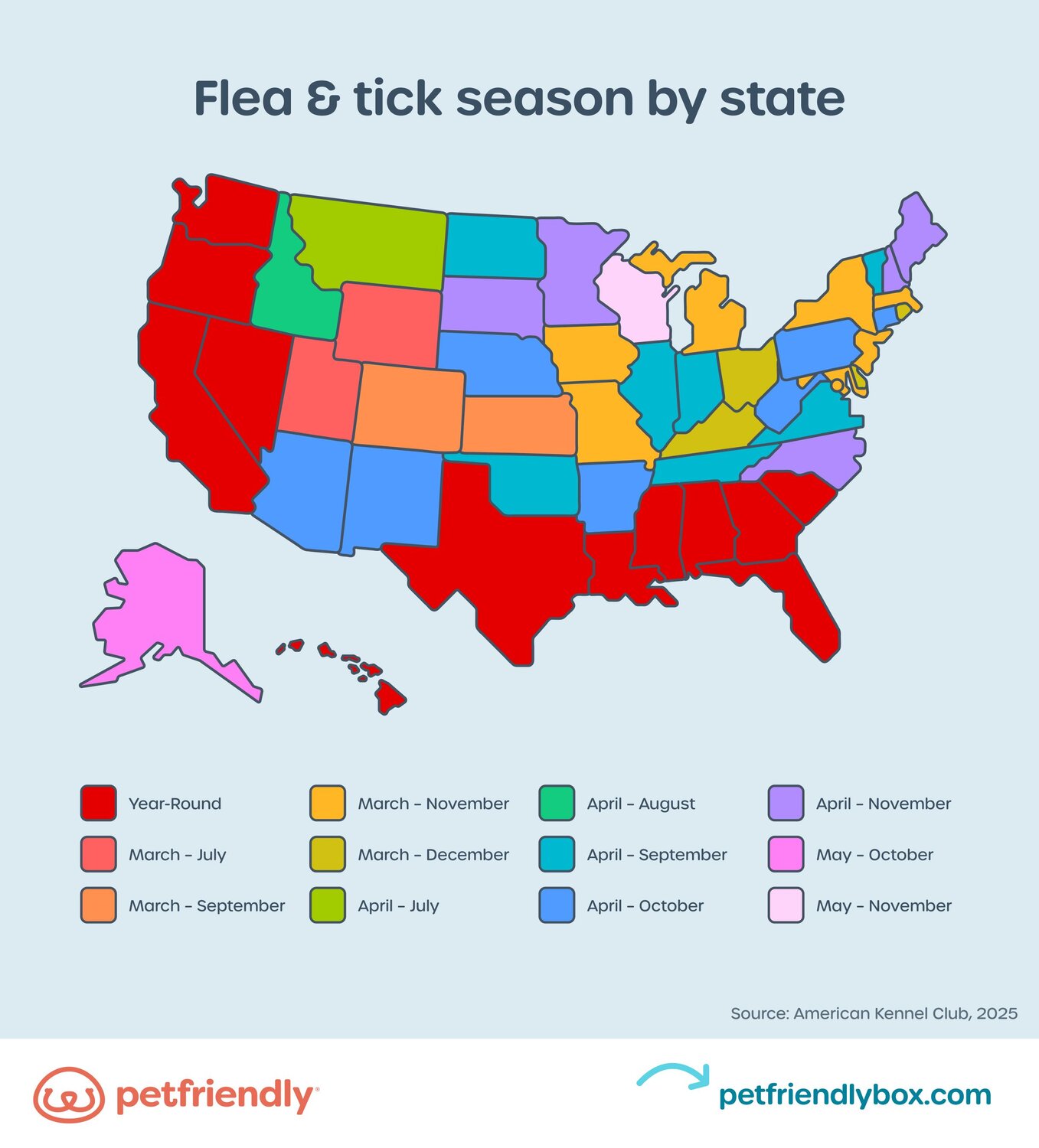Fleas and ticks are a few of the many pests that can wreak havoc on your pets and household. So when is flea & tick season and where are they the biggest threat to both you and your beloved dog or cat?
Explore this article to find out:
- When fleas are the largest threat in your state
- What are fleas and ticks and where do they live
- How to prepare and protect your pet from unwanted diseases
Are fleas and ticks seasonal

Fleas and ticks have impeccable fighting power. Even in colder months, they will do anything to stay alive. While these pesky parasites tend to increase as temperatures rise, they aren’t completely seasonal.
What time of year are fleas most active
Temperature and humidity play a big role in creating the perfect climate for flea and tick activity. The ideal temperature ranges from 75° to 85° F and around 90% humidity. Both thrive in warm climates and fleas are particularly favorable to humid conditions.
Fleas are most active in the early spring, summer, and fall. Ticks live in wooded areas and tall grass starting in the spring through the fall season.
Adult fleas may have a hard time surviving harsh winters. But flea eggs, flea pupae, and larvae can survive all year. Common hiding spots where pets spend time include your attic, floorboards, and furniture.
Dealing with an active flea infestation?
Knocking out all stages of the flea life cycle is the only way to get rid of fleas and keep them from coming back. Cyclekiller is our proven method to eliminate them. Get everything you need to get rid of fleas delivered to your door with overnight shipping.

So when do you need to worry about protecting your pets? Here’s what you need to know about the seasonality of parasites in your area.
When is flea season

Flea season can last anywhere from 6-9 months to all year round in some states. Fleas love warm temperatures, so your flea and tick season can start early in spring and last until September, October, or November.
What months do fleas and ticks thrive
In the United States, they are prevalent all year long in warmer climates. Besides the winter months, the most common include:
- March
- April
- May
- June
- July
- August
- September
Flea and tick season map by state

Source: American Kennel Club, 2025
When does flea & tick season start in each state
| Months | States |
|---|---|
| Year-round | Washington, Oregon, California, Nevada, Hawaii, Texas, Louisiana, Mississippi, Alabama, Georgia, South Carolina, Florida |
| March | Wyoming, Utah, Colorado, Kansas, Iowa, Missouri, Ohio, Kentucky, Rhode Island, Delaware, Michigan, Massachusetts, New Jersey, New York |
| April | Montana, Idaho, North Dakota, Oklahoma, Arizona, New Mexico, Arkansas, Illinois, Indiana, Pennsylvania, West Virginia, Virginia, Tennessee, South Dakota, Minnesota, Maine, New Hampshire, Vermont, Connecticut, North Carolina, Nebraska |
| May | Alaska, Wisconsin |
When is flea & tick season over in each state
| Months | States |
|---|---|
| Year-round | Washington, Oregon, California, Nevada, Hawaii, Texas, Louisiana, Mississippi, Alabama, Georgia, South Carolina, Florida |
| July | Wyoming, Utah, Montana, Idaho |
| September | Colorado, Kansas, North Dakota, Oklahoma, Illinois, Indiana, Tennessee, Virginia, Vermont |
| October | Arizona, New Mexico, Nebraska, Arkansas, West Virginia, Pennsylvania, Connecticut, Alaska |
| November | Iowa, Missouri, Michigan, New York, Massachusetts, New Jersey, Maryland, South Dakota, Minnesota, Maine, New Hampshire, North Carolina, Wisconsin |
| December | Ohio, Kentucky, Rhode Island, Delaware |
California

California is a vast area that spans the entire west coast. This geography makes for a variety of climates and temperatures depending on where you live.
While most of California is warm and dry, there are some areas that are far more humid and wet. Mild temperatures make California the perfect home for fleas, ticks, mosquitoes, and more.
Florida

If you’ve ever visited Florida you know how humid it can be no matter the time of year. Florida is part of the humid subtropical climate zone, making for long, hot summers and mild, wet winters. Because of this, fleas and ticks can be big issues for your pets year-round.
New York

New York is part of the humid continental climate zone. Bordered by several large bodies of water, New York has warm summers and cold winters. Large urban areas also make it easier for your dog to host fleas even as it gets colder. These are ideal conditions for fleas to survive cold weather.
Large urban areas also make it easier for your dog to host fleas even as temperatures drop. These are ideal conditions for fleas to survive cold weather.
Michigan and Ohio

Unlike other midwestern states, Michigan and Ohio get hit a little harder by pests. This is due to large bodies of water and tall grasses nearby. Both states are part of the humid continental zones and experience mild to hot summers with rain all year.
Pennsylvania

Like much of the northeastern United States, Pennsylvania falls in the humid continental climate zone. Similar to New York, this area suffers from hot, wet summers and tons of rain. Mild, damp conditions are great for fleas, ticks, and mosquitoes.
Texas

Texas’ size ensures there are several climate zones represented throughout. Hot semi-arid climates are prevalent along the border of Mexico. And in the eastern part of the state, you might experience humid subtropical climates. Either way, fleas and ticks are a year-round threat to your pets.

What are ticks and where to find them
There are over 200 types of ticks in the United States. Ticks transmit diseases (like Lyme disease) when they feed on the blood of animals like dogs, cats, and rodents. Most species of ticks are typically found east of the Rocky Mountains.
Common types of ticks in the United States
| Tick species | Tick-borne diseases |
|---|---|
| American dog tick | Ehrlichiosis, Rocky Mountain spotted fever, Tularemia |
| Blacklegged tick | Lyme disease, Babesiosis, Anaplasmosis |
| Brown dog tick | Rocky Mountain spotted fever |
| Lone star tick | Ehrlichiosis |

But, even if you live in a western geographic location, you aren’t entirely out of the woods. Ticks and tick bites can be an even bigger problem if you live in more rural areas (i.e. tick-infested regions).
During peak flea season, hiking in tall grass and wooded areas is an easy way to encounter ticks or adult fleas. Be sure you use preventive measures like flea and tick medication to keep your pet safe from:
- Diseases like Lyme disease
- A tick bite
- A flea bite
- Skin infections
What are fleas and where to find them
Finding fleas on dogs or cats isn’t fun. They are easy to pick up from places like the dog park or kennel. And, they can become an even bigger issue if they remain active in your home.
Fleas are extremely common in indoor or outdoor cats and dogs, and they live all over the world. Fleas tend to find an animal host (like your pets) to feed on and reproduce. Their itchy bites can cause health issues, hair loss, bacterial infection, and bacterial disease.
Common types of fleas in the United States
| Flea species | Flea-borne illnesses |
|---|---|
| Cat fleas | Cat scratch disease (CSD), Murine typhus |
| Dog fleas | Tapeworm |
| Ground squirrel flea | Bubonic plague |
| Oriental rat fleas | Bubonic plague, Murine typhus |

How to prepare your pet for fleas and ticks
By now you know that these disease-ridden parasites are a nuisance every year. But do dogs need flea and tick prevention in the winter? What about cats? How can your veterinarian help you and your pet?
No matter where you live, it’s best to use preventive medication to avoid tick bites or an active flea infestation. As a rule of thumb, there is no real dormant period or "off season" for flea and tick season.
Even in the winter months, continuous treatments can be helpful for year-round flea prevention for your pet. The best strategy is to at least start in your state’s peak month.

Here are some other ways you can prepare for the warmer months ahead.
Learn where to check your pet for pests
There are common areas where parasites like to nest on your pet. Know the signs of fleas like:
- Flea dirt
- Flea bites
- Skin irritation
- Red bumps
And, know where to look for ticks on your pet’s skin. Be sure no area is left unchecked with the naked eye, and don’t be afraid to get a closer look with a magnifying glass.
Understand how to remove ticks on dogs
There are lots of myths about tick removal. Be sure you know the right way to remove them from your pet and what tools you need (like a flea comb).
Know how to treat flea eggs and fleas found on pets
Just like tick removal, there's a lot of misinformation about getting rid of a flea infestation. Female fleas can lay 40-50 eggs per day, so it’s important for cat and dog owners to remove flea eggs and treat fleas quickly. Do your research and make sure you're taking care of every life stage on your dog or cat.
Clean and safeguard your house
Infestations don't stop at your pet. They can also infest your home. In the warmer months during the spring and summer, cut tall grass short to discourage bugs in your yard.
Use a household spray with an insect growth regulator (IGR) and wash pet bedding regularly in soapy, hot water to kill fleas and protect against future flea infestations. Regularly vacuum floors, carpets, and area rugs where fleas nest, and dispose of your vacuum bag in an outdoor trash can.

Consult with your veterinarian
Not every dog or cat responds the same to preventative medication. Check with your vet if you're unsure of the right flea treatment to prevent fleas from biting your pet.
Monitor your pet's health
Keep up with your pet's vaccination schedule and nutrition. If your dog or cat exhibits new or odd behavior, contact your vet for a check-up. They can assess their diet and overall health to determine if a supplement is right for them.
Protect your pet year-round
Responsible pet owners stick to a flea and tick prevention plan year round. To keep your furry friends flea-free, choose the right preventative flea and tick treatment that will kill ticks and fleas. This includes all life cycle stages (eggs, larvae, and adults).




